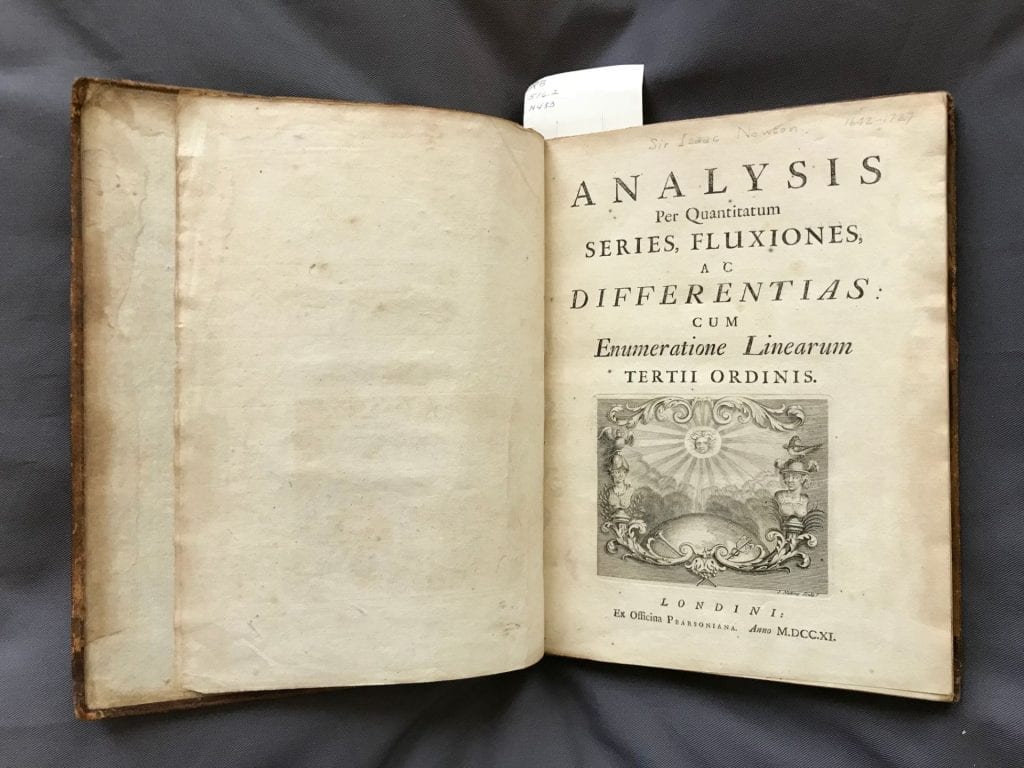Isaac Newton’s Work on Calculus – De analysi (1711)
This is the first of a series of blog posts highlighting notable books from SCUA’s rare book collection brought to light during the preparation for an ongoing retrospective cataloging project, where card catalog records are converted to computerized records for materials held before computer cataloging began. The title described below was discovered in a sub-basement storage location being used as a temporary holding area. It is of interest to note that the item has a check-out sleeve pasted into the back cover indicating that it was at one time in the past part of the library’s circulating collection.
Special Collections and University Archives holds a copy of Isaac Newton’s Analysis per Quantitatum Series, Fluxiones, ac Differentias: cum Enumeratione Linearum Tertii Ordinis (London: Pearson, 1711), the first edition of the third of Newton’s major works on physics and mathematics, following Principia (1687) and Opticks (1704).
Isaac Newton changed the world when he invented Calculus. We take this for granted today, but what Newton accomplished at the age of 24 is simply astonishing. Calculus has uses in physics, chemistry, biology, economics, pure mathematics, all branches of engineering, and more. It’s not an overstatement to say Newton’s insight in the development of calculus has truly revolutionized our ability to pursue new branches of science and engineering. It is used in problems when a quantity changes as a function of time, which is how most problems behave in reality. When he invented calculus and outlined its uses, Isaac Newton made one of the most important breakthroughs in mathematics history, and it’s still vital to this day.
Newton’s own work in physics undoubtedly brought him to this issue, and he felt a need to solve it with a new mathematical framework that simply hadn’t existed up to that point in time. His focus on gravity and laws of motion are linked to his breakthrough in calculus.
Newton started by trying to describe the speed of a falling object. When he did this, he found that the speed of a falling object increases every second, but that there was no existing mathematical explanation for this. The issue of movement and the rate of change had not yet been explored to any significant degree in the field of mathematics, so Newton saw a void that needed to be filled. He began work on this right away, incorporating planetary ellipses into his theory in an attempt to explain the orbit of the planets. He found that by using calculus, he could explain how planets moved and why the orbits of planets are in an ellipse. This is one of Newton’s great epiphanies: that the gravitational force that holds us to the ground is the same force that causes the planets to orbit the Sun and the Moon to orbit Earth.
Calculus is used in all branches of math, science, engineering, biology, and more. There is a lot that goes into the use of calculus, and there are entire industries that rely on it very heavily. For example, any sector that plots graphs and analyzes them for trends and changes will probably use calculus in one way or another. There are certain formulae in particular that demand the use of calculus when plotting graphs. And if a graph’s dimensions have to be accurately estimated, calculus will be used. It’s sometimes necessary to predict how a graph’s line might look in the future using various calculations, and this demands the use of calculus too. Engineering is one sector that uses calculus extensively. Mathematical models often have to be created to help with various forms of engineering planning. And the same applies to the medical industry. Anything that deals with motion, such as vehicle development, acoustics, light and electricity will also use calculus a great deal because it is incredibly useful when analyzing any quantity that changes over time. So, it’s quite clear that there are many industries and activities that need calculus to function in the right way. It might be close to 350 years since the idea was invented and developed, but its importance and vitality has not diminished since it was invented.
Newton’s first independent treatise was written in 1669 and later published in 1711 by the Royal Society during the on-going dispute with Leibniz over who invented calculus. These writings document Newton’s own contributions in the development of calculus. William Jones (1675-1749), a Welsh mathematician noted for his use of the symbol π to represent the ratio of the circumference to the diameter of a circle, wrote the prologue and edited this volume of collected works and it includes the following writings:
- “De analysi per aequationes numero terminorum infinitas” (written in 1669 and circulated in manuscript and published here for the first time; it contains the first printed account of the binomial theorem);
- Two treatises first published in the Opticks but written in 1693 and 1695 titled “De quadratura curvarum” and “Enumeratio linearum tertii ordinis”;
- “Methodus differentialis” (written in 1676 and published here for the first time; it is the basis of the calculus of finite differences);
- “Epistola prior” and “Epistola posterior,” a letter from Newton to Collins, written November 8th, 1676 and a letter to Wallis dated August 27, 1692.
Newton described De analysi to a colleague as:
“a compendium of the method of these [infinite] series, in which I let it be known that, from straight lines given, the areas and lengths of all the curves and the surfaces and volumes of all the solids [formed] could be determined, and conversely with these [taken as] given the straight lines could be determined, and I illustrated the method there outlined by several series.”
This copy of De analysi is a quarto and has 101 pages with 7 preliminary leaves. It measures 24 cm high. The title page includes an engraved allegorical vignette by Joseph Nutting (1660–1722), an English engraver known for his portraits in book frontispieces, which features a small portrait of Newton. Also included are two engraved tables and engraved head and tail-pieces throughout the text. It is bound in mottled calf with a red morocco lettering piece on spine.




Interesting
Thank you.